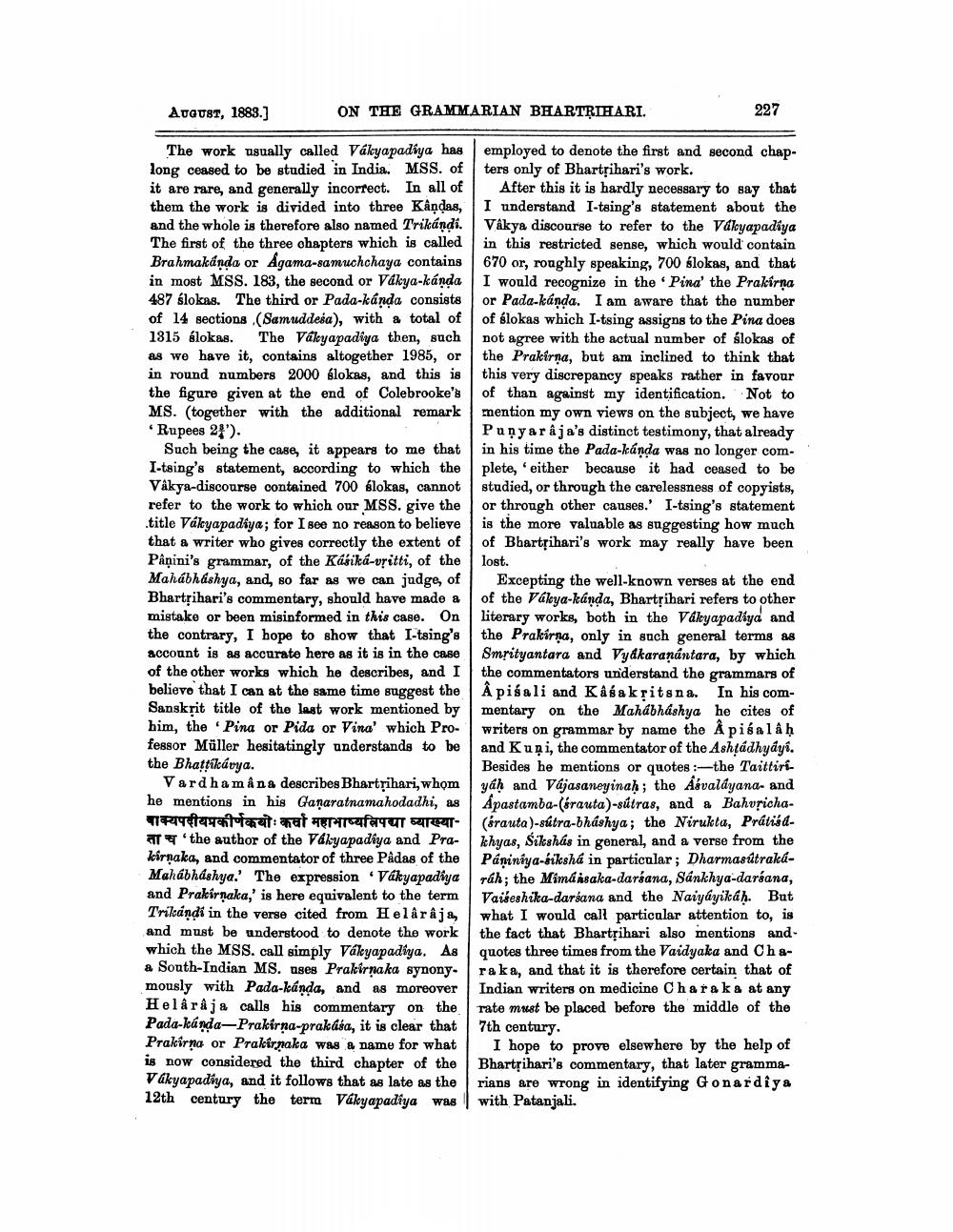________________
ON THE GRAMMARIAN BHARTRIHARI.
AUGUST, 1883.]
The work usually called Vakyapadiya has long ceased to be studied in India. MSS. of it are rare, and generally incorrect. In all of them the work is divided into three Kândas, and the whole is therefore also named Trikándi. The first of the three chapters which is called Brahmakanda or Agama-samuchchaya contains in most MSS. 183, the second or Vakya-kanda 487 slokas. The third or Pada-kanda consists of 14 sections (Samuddesa), with a total of 1815 slokas. The Vakyapadiya then, such as we have it, contains altogether 1985, or in round numbers 2000 slokas, and this is the figure given at the end of Colebrooke's MS. (together with the additional remark 'Rupees 2').
Such being the case, it appears to me that I-tsing's statement, according to which the Vakya-discourse contained 700 slokas, cannot refer to the work to which our MSS. give the title Vakyapadiya; for I see no reason to believe that a writer who gives correctly the extent of Panini's grammar, of the Kásiká-vritti, of the Mahábháshya, and, so far as we can judge, of Bhartrihari's commentary, should have made a mistake or been misinformed in this case. On the contrary, I hope to show that I-tsing's account is as accurate here as it is in the case of the other works which he describes, and I believe that I can at the same time suggest the Sanskrit title of the last work mentioned by him, the Pina or Pida or Vina' which Professor Müller hesitatingly understands to be the Bhaṭṭikávya.
Vardhamâna describes Bhartrihari, whom he mentions in his Ganaratnamahodadhi, as वाक्यपदीयप्रकीर्णकयोः कर्त्ता महाभाष्यविपद्या व्याख्या
the author of the Vakyapadiya and Prakirnaka, and commentator of three Pâdas of the Mahábháshya.' The expression Vakyapadiya and Prakirṇaka,' is here equivalent to the term Trikandi in the verse cited from Helârâja, and must be understood to denote the work which the MSS. call simply Vakyapadiya. As a South-Indian MS. ases Prakirnaka synonymously with Pada-kánda, and as moreover Helârâja calls his commentary on the Pada-kanda-Prakirna-prakása, it is clear that Prakirna or Prakirnaka was a name for what is now considered the third chapter of the Vakyapadiya, and it follows that as late as the 12th century the term Vakyapadiya was
227
employed to denote the first and second chapters only of Bhartrihari's work.
After this it is hardly necessary to say that I understand I-tsing's statement about the Vakya discourse to refer to the Vakyapadiya in this restricted sense, which would contain 670 or, roughly speaking, 700 slokas, and that I would recognize in the 'Pina' the Prakirna or Pada-kanda. I am aware that the number of slokas which I-tsing assigns to the Pina does not agree with the actual number of slokas of the Prakirna, but am inclined to think that this very discrepancy speaks rather in favour of than against my identification. Not to mention my own views on the subject, we have Punyaraja's distinct testimony, that already in his time the Pada-kanda was no longer complete, either because it had ceased to be studied, or through the carelessness of copyists, or through other causes.' I-tsing's statement is the more valuable as suggesting how much of Bhartrihari's work may really have been lost.
Excepting the well-known verses at the end of the Vakya-kanda, Bhartrihari refers to other literary works, both in the Vakyapadiya and the Prakirna, only in such general terms as Smrityantara and Vyakaranántara, by which the commentators understand the grammars of Apisali and Kâsakritsna. In his commentary on the Mahábháshya he cites of writers on grammar by name the Apisalaḥ and Kuņi, the commentator of the Ashtadhyays. Besides he mentions or quotes:-the Taittiriyah and Vajasaneyinah; the Aévalayana- and Apartamba-(Franta)-átras, and a Bahspicha(srauta)-sútra-bhashya; the Nirukta, Prátiśαkhyas, Sikshús in general, and a verse from the Paniniya-siksha in particular; Dharmasútrakáráh; the Mimáisaka-darśana, Sankhya-darśana, Vaiseshika-darśana and the Naiyayikáḥ. But what I would call particular attention to, is the fact that Bhartrihari also mentions andquotes three times from the Vaidyaka and Charaka, and that it is therefore certain that of Indian writers on medicine Charaka at any rate must be placed before the middle of the 7th century.
I hope to prove elsewhere by the help of Bhartrihari's commentary, that later grammarians are wrong in identifying Gonardiya with Patanjali.




